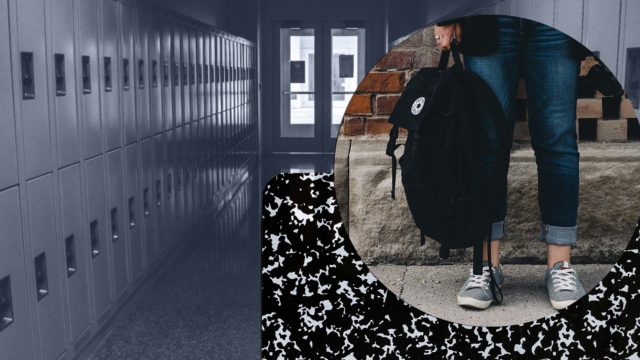How Can We Prevent Gun Violence in American Schools?
These research-backed approaches can help create safer schools and end gun violence.

Introduction
This fact sheet lays out research-backed approaches for creating safer schools and ending gun violence that combine school-based interventions with strong gun safety laws. These actions work to intervene before shootings happen.
What do we know about gun violence in schools?
From 2013 through 2022, Everytown identified 720 incidents of gunfire on the grounds of a preschool or K–12 school, including incidents of gun homicides and assaults, gun suicides and attempts, unintentional shootings, and mass shootings.1For 10 full years beginning in 2013, Everytown collected detailed information on all incidents of gunfire on school grounds. Everytown defined incidents of gunfire on school grounds as “any time a gun discharges a live round inside (or into) a school building, or on (or onto) a school campus or grounds,” where “school” refers to a preschool; elementary, middle, and high schools—K–12—as well as colleges and universities. Of the 1,031 incidents identified at all schools between 2013 and 2022, 720 occurred on the grounds of a preschool, or elementary, middle, high, or K–12 school, resulting in 239 people killed and 504 people wounded. This analysis informs the lessons in this document. The analysis here reflects information related to gunfire on the grounds of preschools and K–12 schools only and is supplemented by external research. More information is available at https://everytownresearch.org/gunfire-in-school/ and https://everytownresearch.org/school-safety-plan.
School shooters usually have a connection to the school.
An Everytown analysis of the New York City Police Department’s review of active shooter incidents in K–12 schools over five decades found that the shooters were current or former students in 75 percent of these incidents.2New York City Police Department, “Active Shooter: Recommendations and Analysis for Risk Mitigation,” 2016, https://on.nyc.gov/2nWHM4O. The New York City Police Department (NYPD) defines an active shooter as “a person(s) actively engaged in killing or attempting to kill people in a confined and populated area.” In its definition, the Department of Homeland Security notes that, “in most cases, active shooters use firearm(s) and there is no pattern or method to their selection of victims.” Everytown limited its analysis of this data to incidents that took place in K–12 schools.
Guns used by shooters under age 18 usually come from the home.
76%
Roughly three-quarters of school shooters under the age of 18 got the gun from their home or the home of a close relative.
“Protecting America’s Schools: A US Secret Service Analysis of Targeted School Violence”. National Threat Assessment Center. (2019). https://bit.ly/2U7vnwa
A US Secret Service analysis of nearly 40 years of school violence found that roughly three-quarters of school shooters’ guns came from the home of a parent or close relative.3National Threat Assessment Center, “Protecting America’s Schools: A US Secret Service Analysis of Targeted School Violence,” US Secret Service, Department of Homeland Security, 2019, https://bit.ly/2U7vnwa.
School shooters nearly always exhibit advance warning signs.
In all incidents of targeted school violence—100 percent—there were warning signs that caused others to be concerned.4National Threat Assessment Center, “Protecting America’s Schools: A US Secret Service Analysis of Targeted School Violence,” US Secret Service, Department of Homeland Security, 2019, https://bit.ly/2U7vnwa.
School gun violence has a disproportionate impact on students of color.
Two in three incidents of gunfire on school grounds from 2013 to 2021 occurred in schools where one or more racial and/or ethnic minorities constituted a majority of the student population.5Everytown Research analysis of Gunfire on School Grounds database, 2013 to 2021. Everytown for Gun Safety Support Fund, “How to Stop Shootings and Gun Violence in Schools: A Plan to Keep Students Safe, “ August 19, 2022, https://everytownresearch.org/school-safety-plan.
How can we prevent school gun violence?
Gun violence prevention policies that will help to end school gun violence include:
Secure Storage And Child-Access Prevention (CAP) Laws
4.6M
4.6 million children in the United States live in homes with at least one gun that is loaded and unlocked.
An estimated 4.6 million American children live in households with at least one loaded and unlocked firearm.6Matthew Miller and Deborah Azrael, “Firearm Storage in US Households with Children: Findings from the 2021 National Firearm Survey,” JAMA Network Open 5, no. 2 (2022): e2148823, https://doi.org/10.1001/jamanetworkopen.2021.48823. Secure storage and CAP laws hold gun owners accountable if a child can or does access firearms that are not securely stored. 7Everytown for Gun Safety Support Fund, “Everytown Gun Law Rankings: Which States Have Child-Access and/or Secure Storage Laws?,” https://everytownresearch.org/rankings/law/secure-storage-or-child-access-prevention–required/. Since the vast majority of school shooters under age 18 acquire guns from the home, secure storage is an essential ingredient for preventing gun violence in schools.
Extreme Risk Laws
This policy empowers family members, law enforcement, and, in some states, educators, to petition a civil court to temporarily prevent a person from accessing guns. Extreme Risk laws allow people in crisis times to get the help they need. As of April 2023, 19 states and the District of Columbia have enacted Extreme Risk laws.8For the most up-to-date list of states that have enacted Extreme Risk laws, visit https://everytownresearch.org/rankings/law/extreme-risk-law/. These laws are a vital tool for law enforcement in cases where a person who poses a risk to a school has access to firearms.9Everytown for Gun Safety Support Fund, “Extreme Risk Laws Save Lives: Stories,” March 13, 2023, https://everytownresearch.org/report/appendix-a-extreme-risk-laws-save-lives-stories/.
Raising the Minimum Age to Purchase Semiautomatic Firearms to 21
This policy can help block gun sales to teenagers. Data show that 18- to 20-year-olds commit gun homicides at triple the rate of adults 21 and older.10Everytown Research analysis using FBI Supplementary Homicide Report (SHR) and US Census American Community Survey data, 2016–2020.
Background Checks
Requiring background checks on all gun sales can prevent teenagers and prohibited persons from taking advantage of the background checks loophole, which allows people to buy a firearm online or at a gun show with no background check.11Everytown for Gun Safety Support Fund, “Everytown Gun Law Rankings: Which States Require Background Checks and/or Permits to Purchase Handguns?,” https://everytownresearch.org/rankings/law/background-check-and-or-purchase-permit/; Everytown for Gun Safety Support Fund, “Update Background Check Laws,” June 22, 2021, https://everytownresearch.org/report/update-background-check-laws/.
School-based interventions that play a vital role in keeping schools safe include:
Fostering a Safe and Trusting School Climate for All Students
Students thrive in positive school environments. Supportive schools foster an affirming academic climate12National Center on Safe Supportive Learning Environments, “School Climate Improvement,” accessed April 21, 2023, https://safesupportivelearning.ed.gov/school-climate-improvement. while also creating conditions where children have adults with whom they feel safe asking for help or reporting concerning behavior.13Sandy Hook Promise, “Know the Signs Programs,” accessed April 21, 2023, https://bit.ly/2S9fgPa; Hsing-Fang Hsieh et al., “The Effectiveness of the Say-Something Anonymous Reporting System in Preventing School Violence: A Cluster Randomized Control Trial in 19 Middle Schools,” Journal of School Violence 21, no. 4 (2022), https://doi.org/10.1080/15388220.2022.2105858.
Safe schools are built on trusting relationships among students, staff, and administrators.
Implementing Crisis Intervention Programs to Help Schools Identify and Deescalate Dangerous Situations
Schools should work with community partners to create trauma-informed crisis intervention practices to intervene before a person commits an act of violence.14Jillian Peterson, James Densley, and Missy Dodds, “The R-Model: Ready-Respond-Refer-Revisit, K–12 School Crisis Response Teams,” accessed April 21, 2023, https://off-ramp.org/wp-content/uploads/2021/04/R-Model-Protocol-Final-2.pdf. A 2018 Department of Homeland Security report stated that “preventing violence by detecting and addressing these [behavioral] red flags is more effective than any physical security measure.”15US Department of Homeland Security, “K–12 School Security: A Guide for Preventing and Protecting against Gun Violence, 2nd Edition,” 2018, https://bit.ly/41LxK7y. Successful crisis interventions uphold students’ civil rights and avoid a disproportionate impact on historically marginalized students and students with disabilities, address student access to guns, and provide appropriate school-based mental health services.16Everytown for Gun Safety Support Fund, “How to Stop Shootings and Gun Violence in Schools: A Plan to Keep Students Safe, “ August 19, 2022, https://everytownresearch.org/school-safety-plan; National Threat Assessment Center, “Enhancing School Safety Using a Threat Assessment Model: An Operational Guide for Preventing Targeted School Violence,” US Secret Service, Department of Homeland Security, July 2018, https://bit.ly/3ovPJAC; Jillian Peterson, James Densley, and Missy Dodds, “The R-Model: Ready-Respond-Refer-Revisit, K–12 School Crisis Response Teams,” accessed April 21, 2023, https://off-ramp.org/wp-content/uploads/2021/04/R-Model-Protocol-Final-2.pdf.
Ensuring Sufficient Mental Health Counselors to Create a Safe School Climate
As part of any effective strategy, schools need to ensure that students have adequate access to mental health services, and legislatures need to fund adequate mental health professionals in schools. The National Association of School Psychologists found the average student-to-psychologist ratio to be 1,233 students to one school psychologist—more than double their recommended 500 students.17Anisa N. Goforth et al., “Status of School Psychology in 2020: Part 1, Demographics of the NASP Membership Survey,” NASP Research Reports 5, no. 2 (2021), https://www.nasponline.org/research-and-policy/research-center/member-surveys.
Informing Parents About Secure Gun Storage
School districts can help prevent shootings by notifying families about the critical importance of secure firearms storage.18Students Demand Action, “Urge Your School Board to Act on School Safety,” January 26, 2022, https://studentsdemandaction.org/report/urge-your-school-board-to-act-on-school-safety/. Public awareness campaigns like the Be SMART program, developed by Everytown, educate the school community on secure gun storage.19Tyler Kingkade, “How Moms Are Quietly Passing Gun Safety Policy through School Boards,” NBC News, February 10, 2020, https://nbcnews.to/3azPWHf. School districts across the country are passing resolutions requiring schools to provide parents with resources about secure gun storage.20As of early 2023, more than 8.5 million students attend schools with a secure storage notification policy. Everytown for Gun Safety, “More Than 8.5 Million Students Nationwide Will Attend Schools with Secure Firearm Storage Policies during Next School Year Following Passage of Orange County, Florida Resolution,” press release, December 15, 2022, https://www.everytown.org/press/more-than-8-5-million-students-nationwide-will-attend-schools-with-secure-firearm-storage-policies-during-next-school-year-following-passage-of-orange-county-florida-resolution/. State legislatures can also enact laws mandating this requirement.21Everytown for Gun Safety, ”Following Tireless Advocacy by California Moms Demand Action, Students Demand Action, California Legislature Passes Groundbreaking Gun Violence Prevention Bills,” press release, August 9, 2022, https://www.everytown.org/press/following-tireless-advocacy-by-california-moms-demand-action-students-demand-action-california-legislature-passes-groundbreaking-gun-violence-prevention-bills/.
Implementing School Security Enhancements
School safety experts22Sandy Hook Advisory Commission, “Final Report of the Sandy Hook Advisory Commission: Presented to Governor Dannel P. Malloy, State of Connecticut,” March 6, 2015, https://tinyurl.com/yaufdwbp; Marjory Stoneman Douglas High School Public Safety Commission, “Initial Report Submitted to the Governor, Speaker of the House of Representatives and Senate President,” January 2, 2019, https://bit.ly/37Gaoop. recommend that schools implement both access control measures, such as single-access points, fencing, or external door locks, and interior door locks to enable educators to lock out shooters as proven intervention points.
Which school safety measures have been harmful to students?
Arming teachers is not an effective strategy for preventing gun violence in schools.
Everytown shares the earnest desire to respond. But arming teachers puts the whole school at greater risk. Studies show that even highly trained law enforcement see their ability to shoot accurately in “split-second” situations decrease significantly.23Bernard D. Rostker et al., “Evaluation of the New York City Police Department Firearm Training and Firearm-Discharge Review Process,” RAND Corporation, 2008, https://bit.ly/2U9bk0t. In addition, to expect teachers to neutralize an active shooter, possibly even a former student, is dangerous and unrealistic. Finally, armed teachers complicate the response of law enforcement in already complex, fast-moving situations.
Overpolicing of schools has had detrimental impacts on students.
3x
Black students in the US are three times more likely to be arrested in school than white students.
Emily K. Weisburst, “Patrolling Public Schools: The Impact of Funding for School Police on Student Discipline and Long-Term Education Outcomes,” Journal of Policy Analysis and Management, February 7, 2019, https://doi.org/10.1002/pam.22116.
Not only have School Resource Officers (SROs) not been shown to reduce deaths or injuries from school shootings or gun-related incidents in schools, but research demonstrates that their presence contributes to more suspensions, expulsions, and arrests, as well as increased absenteeism and decreased graduation rates.24Melvin D. Livingston, Matthew E. Rossheim, and Kelli Stidham Hall, “A Descriptive Analysis of School and School Shooter Characteristics and the Severity of School Shootings in the United States, 1999–2018,” Journal of Adolescent Health 64, no. 6 (June 2019): 797–99, https://doi.org/10.1016/j.jadohealth.2018.12.006; Jillian Peterson, James Densley, and Gina Erickson, “Presence of Armed School Officials and Fatal and Nonfatal Gunshot Injuries during Mass School Shootings, United States, 1980–2019,” JAMA Network Open 4, no. 2 (2021): e2037394, https://doi.org/10.1001/jamanetworkopen.2020.37394; Lucy C. Sorensen et al., “The Thin Blue Line in Schools: New Evidence on School-Based Policing across the US,” EdWorkingPaper 21-476, August 2022, https://doi.org/10.26300/heqx-rc69; Amir Whitaker et al., “Cops and No Counselors: How the Lack of School Mental Health Staff Is Harming Students,” American Civil Liberties Union, March 2019, https://bit.ly/3xzz0fF; Emily K. Weisburst, “Patrolling Public Schools: The Impact of Funding for School Police on Student Discipline and Long-Term Education Outcomes,” Journal of Policy Analysis and Management 38, no. 2 (2019): 338–65, https://doi.org/10.1002/pam.22116. In addition, the presence of SROs leads to particularly severe and disproportionate consequences for Black, Indigenous, and Latinx students, as well as students with disabilities.25Emily M. Homer and Benjamin W. Fisher, “Police in Schools and Student Arrest Rates across the United States: Examining Differences by Race, Ethnicity, and Gender,” Journal of School Violence 19, no. 2 (April 2, 2020): 192–204, https://doi.org/10.1080/15388220.2019.1604377; Deborah Fowler et al., “Dangerous Discipline: How Texas Schools Are Relying on Law Enforcement, Courts, and Juvenile Probation to Discipline Students,” Texas Appleseed and Texans Care for Children, December 14, 2016, https://report.texasappleseed.org/dangerous-discipline/; Nora Gordon, “Disproportionality in Student Discipline: Connecting Policy to Research,” Brookings (blog), January 18, 2018, https://brook.gs/3dlLak7; Amir Whitaker et al., “Cops and No Counselors: How the Lack of School Mental Health Staff Is Harming Students,” American Civil Liberties Union, March 2019, https://bit.ly/3xzz0fF. If schools do choose to have SROs, it is essential to put in place several guardrails: officers should not act in disciplinary roles, they must be answerable to school leaders, and training in minimum-use-of-force techniques should be required.
Active shooter drills increase anxiety in the whole school community.
Training school staff on how to respond to active shooter situations is important. But there is no strong conclusive evidence that supports the value of drills involving students, neither for preventing shootings nor for protecting the school community. In fact, there is mounting evidence that student-involved drills are associated with lasting harms, such as increases in depression, stress, and anxiety, as well as widespread fear of death throughout the school community.26Everytown for Gun Safety Support Fund, “The Impact of Active Shooter Drills in Schools: Time to Rethink Reactive School Safety Strategies,” 2020, https://everytownresearch.org/reports/the-impact-of-active-shooter-drills-in-schools; Mai ElSherief et al., “Impacts of School Shooter Drills on the Psychological Well-Being of American K–12 School Communities: A Social Media Study,” Humanities and Social Sciences Communications 8, no. 315 (2021), https://doi.org/10.1057/s41599-021-00993-6.
Conclusion
Policymakers can help prevent gun violence in schools by implementing proactive, evidence-based interventions. Targeted gun violence prevention policies can prevent guns from falling into the wrong hands and being used in a school-based shooting. School-based strategies can work to intervene when a student shows signs of crisis. Planning and security strategies, as a last line of defense, can ensure that a school is prepared to quickly respond appropriately to any threat. Our leaders must take responsible action to keep our schools safe. They can do so with data-driven strategies that have been proven to reduce violence in schools.
Additional Resources
Everytown Research & Policy is a program of Everytown for Gun Safety Support Fund, an independent, non-partisan organization dedicated to understanding and reducing gun violence. Everytown Research & Policy works to do so by conducting methodologically rigorous research, supporting evidence-based policies, and communicating this knowledge to the American public.



